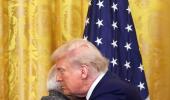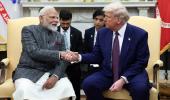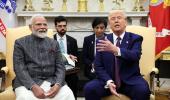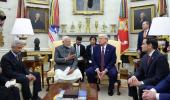'The US has agreed to negotiate with us a mutually beneficial bilateral trade agreement, which will go for reduction of tariffs on both sides so that our trade can grow.'

India is hopeful that the US will "take care" of its concerns regarding additional import levies on steel and aluminium, and the proposed reciprocal tariffs during the bilateral trade agreement (BTA) discussions that are expected to begin in the next few weeks.
New Delhi is also trying to decipher what will be the shape of the US' proposed reciprocal tariff law before drawing conclusions regarding its consistency with respect to global trade norms under the World Trade Organisation, a senior government official said on Monday.
"The US and India have agreed to move in the direction of mutually beneficial and fair BTA that takes care of everything, whatever they announce. We will have a mutually beneficial trade agreement. Everything will be addressed through this forum -- their negotiators and ours will mutually discuss these issues," the government official told reporters.
Commerce department officials are also trying to gauge if there's an "opportunity" for India amid tariff-related uncertainties and a threat of a larger global war due to the protectionist trade policies being rolled out by the Donald Trump administration.
The department will soon hold consultations with the industry and also do a cost-benefit analysis of the evolving scenario.
This comes against the backdrop of the restart of the trade war between the US and China, and a potential tariff conflict with its neighbouring Mexico and Canada.
The European Commission has also raised concerns over the US's reciprocal trade policy and has vowed to retaliate against steel and aluminium tariffs that will kick in from March.
Prime Minister Narendra D Modi and the US President on Thursday, February 13. agreed to begin negotiations and finalise the first tranche of a mutually beneficial, multi-sector BTA within the next seven-to-eight months.
According to the joint statement, both countries will hold talks for increasing market access, reducing tariff and non-tariff barriers, and deepening supply chain integration. The proposed trade deal will be in line with the aim to double the bilateral trade to $500 billion by 2030.
However, it is not clear whether the tariff reduction under the trade deal will be implemented on a most favoured nation (MFN) basis or on a country-to-country basis.
Besides, currently, there is no clarity on the scope and extent of the trade agreement.
India is waiting for the appointment of the US Trade Representative (USTR). Once the American negotiating team is in place, over the next few weeks, both countries will decide on the nature of the proposed trade agreement.
"The US has agreed to negotiate with us a mutually beneficial bilateral trade agreement, which will go for reduction of tariffs on both sides so that our trade can grow," the official cited above said.
The two countries have also agreed to collaborate to enhance bilateral trade by increasing US exports of industrial goods to India and Indian exports of labour-intensive manufactured products across sectors such as auto components, textiles, and gems AND jewellery to the US.
They will also work together to increase trade in agricultural goods. India exports agri goods worth more than $4 billion to America and that will get a further boost.
During the first term of Trump, the two countries had discussed a mini-trade deal, but it was not finalised due to key differences. Thereafter, in 2021, when the Joe Biden administration took over, it was understood that they were not in favour of such pacts.
A 15 to 20 per cent tariff increase by the United States on India as part of its reciprocal tariff plan would impact India's shipments only in the range of 3 to 3.5 per cent, after factoring in exchange rate depreciation, State Bank of India Research said in a report released on Monday.
US President Donald J Trump last week announced his plans to impose country-specific reciprocal tariffs to address 'unfair and unbalanced' aspects of bilateral trade.
The US claimed that its average applied Most Favoured Nation (MFN) tariff on agricultural goods is 5 per cent, while India's average applied MFN tariff is 39 per cent.
Holding that tariff reciprocity may turn out to be more of 'white noise', SBI Research said even the expected impact should be negated through higher export goals, as India has diversified its exports portfolio, increased value addition, explored alternative markets, and worked on new trade routes spanning from Europe to the US via the Middle East, redrawing supply chain strategies to foster strategic inclusivity.
India and the US have set a new goal for bilateral trade under 'Mission 500', aiming to more than double total bilateral trade to $500 billion by 2030.
The SBI report said while US tariffs on Indian exports have remained relatively stable, India's tariff adjustments appear to be more dynamic.
'The US tariff rate on Indian goods increased from 2.72 per cent in 2018 to 3.91 per cent in 2021, before slightly declining to 3.83 per cent in 2022. India's tariffs on US imports have risen from 11.59 per cent in 2018 to 15.30 per cent in 2022,' it added.












 © 2025
© 2025